Grzegorz Beringer
Investigating self-supervised features for expressive, multilingual voice conversion
May 13, 2025



Abstract:Voice conversion (VC) systems are widely used for several applications, from speaker anonymisation to personalised speech synthesis. Supervised approaches learn a mapping between different speakers using parallel data, which is expensive to produce. Unsupervised approaches are typically trained to reconstruct the input signal, which is composed of the content and the speaker information. Disentangling these components is a challenge and often leads to speaker leakage or prosodic information removal. In this paper, we explore voice conversion by leveraging the potential of self-supervised learning (SSL). A combination of the latent representations of SSL models, concatenated with speaker embeddings, is fed to a vocoder which is trained to reconstruct the input. Zero-shot voice conversion results show that this approach allows to keep the prosody and content of the source speaker while matching the speaker similarity of a VC system based on phonetic posteriorgrams (PPGs).
* Published as a conference paper at ICASSP 2024
Enhancing the Stability of LLM-based Speech Generation Systems through Self-Supervised Representations
Feb 05, 2024


Abstract:Large Language Models (LLMs) are one of the most promising technologies for the next era of speech generation systems, due to their scalability and in-context learning capabilities. Nevertheless, they suffer from multiple stability issues at inference time, such as hallucinations, content skipping or speech repetitions. In this work, we introduce a new self-supervised Voice Conversion (VC) architecture which can be used to learn to encode transitory features, such as content, separately from stationary ones, such as speaker ID or recording conditions, creating speaker-disentangled representations. Using speaker-disentangled codes to train LLMs for text-to-speech (TTS) allows the LLM to generate the content and the style of the speech only from the text, similarly to humans, while the speaker identity is provided by the decoder of the VC model. Results show that LLMs trained over speaker-disentangled self-supervised representations provide an improvement of 4.7pp in speaker similarity over SOTA entangled representations, and a word error rate (WER) 5.4pp lower. Furthermore, they achieve higher naturalness than human recordings of the LibriTTS test-other dataset. Finally, we show that using explicit reference embedding negatively impacts intelligibility (stability), with WER increasing by 14pp compared to the model that only uses text to infer the style.
SCRAPS: Speech Contrastive Representations of Acoustic and Phonetic Spaces
Jul 23, 2023Abstract:Numerous examples in the literature proved that deep learning models have the ability to work well with multimodal data. Recently, CLIP has enabled deep learning systems to learn shared latent spaces between images and text descriptions, with outstanding zero- or few-shot results in downstream tasks. In this paper we explore the same idea proposed by CLIP but applied to the speech domain, where the phonetic and acoustic spaces usually coexist. We train a CLIP-based model with the aim to learn shared representations of phonetic and acoustic spaces. The results show that the proposed model is sensible to phonetic changes, with a 91% of score drops when replacing 20% of the phonemes at random, while providing substantial robustness against different kinds of noise, with a 10% performance drop when mixing the audio with 75% of Gaussian noise. We also provide empirical evidence showing that the resulting embeddings are useful for a variety of downstream applications, such as intelligibility evaluation and the ability to leverage rich pre-trained phonetic embeddings in speech generation task. Finally, we discuss potential applications with interesting implications for the speech generation and recognition fields.
GlowVC: Mel-spectrogram space disentangling model for language-independent text-free voice conversion
Jul 04, 2022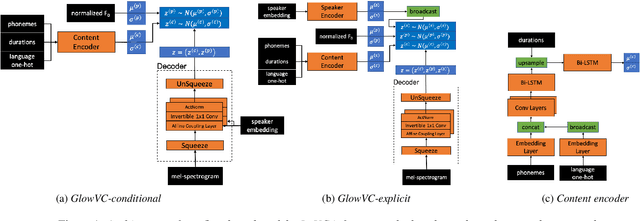

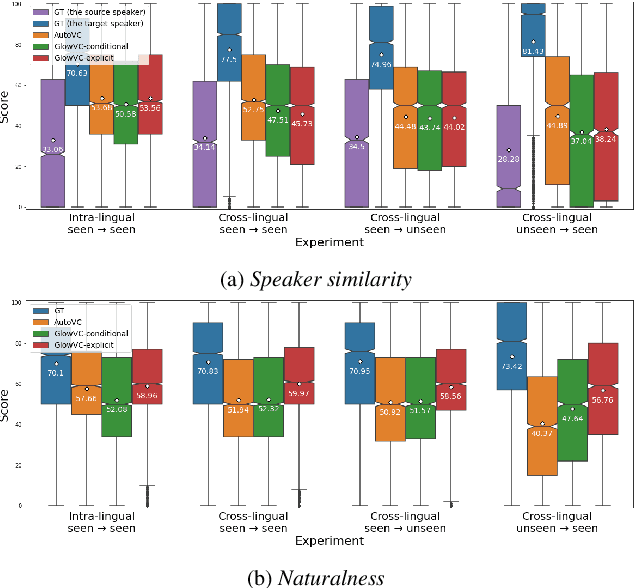
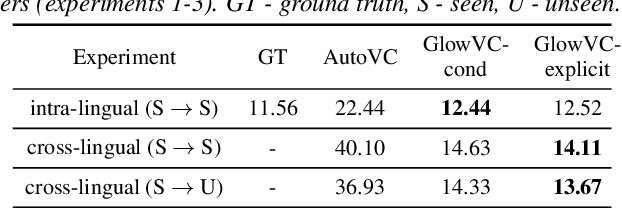
Abstract:In this paper, we propose GlowVC: a multilingual multi-speaker flow-based model for language-independent text-free voice conversion. We build on Glow-TTS, which provides an architecture that enables use of linguistic features during training without the necessity of using them for VC inference. We consider two versions of our model: GlowVC-conditional and GlowVC-explicit. GlowVC-conditional models the distribution of mel-spectrograms with speaker-conditioned flow and disentangles the mel-spectrogram space into content- and pitch-relevant dimensions, while GlowVC-explicit models the explicit distribution with unconditioned flow and disentangles said space into content-, pitch- and speaker-relevant dimensions. We evaluate our models in terms of intelligibility, speaker similarity and naturalness for intra- and cross-lingual conversion in seen and unseen languages. GlowVC models greatly outperform AutoVC baseline in terms of intelligibility, while achieving just as high speaker similarity in intra-lingual VC, and slightly worse in the cross-lingual setting. Moreover, we demonstrate that GlowVC-explicit surpasses both GlowVC-conditional and AutoVC in terms of naturalness.
Improving multi-speaker TTS prosody variance with a residual encoder and normalizing flows
Jun 10, 2021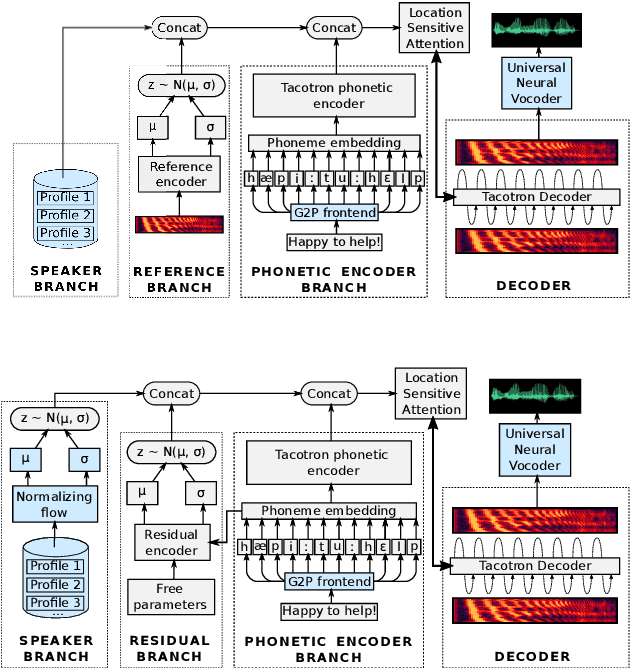

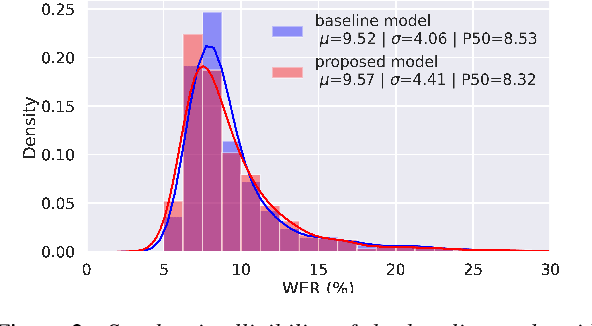

Abstract:Text-to-speech systems recently achieved almost indistinguishable quality from human speech. However, the prosody of those systems is generally flatter than natural speech, producing samples with low expressiveness. Disentanglement of speaker id and prosody is crucial in text-to-speech systems to improve on naturalness and produce more variable syntheses. This paper proposes a new neural text-to-speech model that approaches the disentanglement problem by conditioning a Tacotron2-like architecture on flow-normalized speaker embeddings, and by substituting the reference encoder with a new learned latent distribution responsible for modeling the intra-sentence variability due to the prosody. By removing the reference encoder dependency, the speaker-leakage problem typically happening in this kind of systems disappears, producing more distinctive syntheses at inference time. The new model achieves significantly higher prosody variance than the baseline in a set of quantitative prosody features, as well as higher speaker distinctiveness, without decreasing the speaker intelligibility. Finally, we observe that the normalized speaker embeddings enable much richer speaker interpolations, substantially improving the distinctiveness of the new interpolated speakers.
Detection of Lexical Stress Errors in Non-native English with Data Augmentation and Attention
Dec 29, 2020
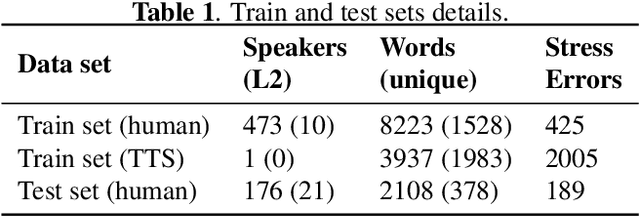
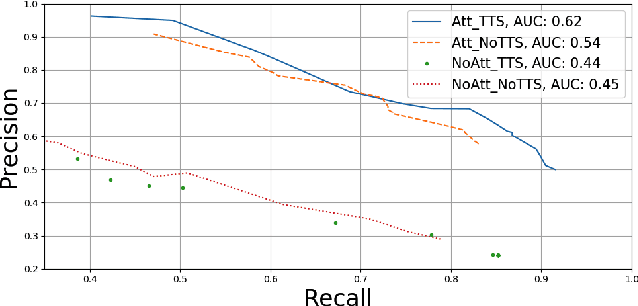

Abstract:This paper describes two novel complementary techniques that improve the detection of lexical stress errors in non-native (L2) English speech: attention-based feature extraction and data augmentation based on Neural Text-To-Speech (TTS). In a classical approach, audio features are usually extracted from fixed regions of speech such as syllable nucleus. We propose an attention-based deep learning model that automatically derives optimal syllable-level representation from frame-level and phoneme-level audio features. Training this model is challenging because of the limited amount of incorrect stress patterns. To solve this problem, we propose to augment the training set with incorrectly stressed words generated with Neural TTS. Combining both techniques achieves 94.8\% precision and 49.2\% recall for the detection of incorrectly stressed words in L2 English speech of Slavic speakers.
 Add to Chrome
Add to Chrome Add to Firefox
Add to Firefox Add to Edge
Add to Edge